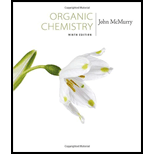
Interpretation:
The stereochemistry of the following pericyclic reactions,
a) The thermal cyclization of a conjugated tetraene.
Concept introduction:
a) A pericyclic reaction is a concerted reaction that proceeds through a cyclic transition state. Pericyclic reactions are completely stereospecific; that is, a single stereoisomer of the reactant forms a single stereoisomer of the product. Various kind of stereochemistry occurs in pericyclic reaction.
Interpretation:
The stereochemistry of the following pericyclic reactions,
b) The photochemical cyclization of a conjugated tetraene.
Concept introduction:
b) When like phases of the p orbitals are on the same side of the molecule, the two orbitals must rotate in opposite directions—one clockwise and one counterclockwise. Rotation in opposite directions is said to be disrotatory.
Interpretation:
The stereochemistry of the following pericyclic reactions,
c) A photochemical [4 1 4] cycloaddition.
Concept introduction:
c) When like phases of the p orbitals are on opposite sides of the molecule, the two orbitals must rotate in the same direction—both clockwise or both counterclockwise. Rotation in the same direction is said to be conrotatory.
Interpretation:
The stereochemistry of the following pericyclic reactions,
d) A thermal [2 1 6] cycloaddition.
Concept introduction:
d) A suprafacial stereochemistry occurs when like phases of the p orbitals of both reactants are on the same side of the pie system, so that two bonding interactions result.
Interpretation:
The stereochemistry of the following pericyclic reactions,
e) A photochemical [3, 5] sigmatropic rearrangement.
Concept introduction:
e) An antarafacial stereochemistry occurs when one pie system must twist to align like phases of the p orbitals of the terminal carbons of the reactants.
Trending nowThis is a popular solution!

Chapter 30 Solutions
Study Guide with Student Solutions Manual for McMurry's Organic Chemistry, 9th
- Hi, I need your help with the drawing, please. I have attached the question along with my lab instructions. Please use the reaction from the lab only, as we are not allowed to use outside sources. Thank you!arrow_forwardHi, I need your help i dont know which one to draw please. I’ve attached the question along with my lab instructions. Please use the reaction from the lab only, as we are not allowed to use outside sources. Thank you!arrow_forward5. Write the formation reaction of the following complex compounds from the following reactants: 6. AgNO₃ + K₂CrO₂ + NH₄OH → 7. HgNO₃ + excess KI → 8. Al(NO₃)₃ + excess NaOH →arrow_forward
- Indicate whether the product formed in the reaction exhibits tautomerism. If so, draw the structure of the tautomers. CO₂C2H5 + CH3-NH-NH,arrow_forwardDraw the major product of this reaction N-(cyclohex-1-en-1-yl)-1-(pyrrolidino) reacts with CH2=CHCHO, heat, H3O+arrow_forwardDraw the starting material that would be needed to make this product through an intramolecular Dieckmann reactionarrow_forward
- Draw the major product of this reaction. Nitropropane reacts + pent-3-en-2-one reacts with NaOCH2CH3, CH3CHOHarrow_forwardIndicate whether the product formed in the reaction exhibits tautomerism. If so, draw the structure of the tautomers. OC2H5 + CoHs-NH-NH,arrow_forwardExplain how substitutions at the 5-position of barbituric acid increase the compound's lipophilicity.arrow_forward
- Explain how substitutions at the 5-position of phenobarbital increase the compound's lipophilicity.arrow_forwardName an interesting derivative of barbituric acid, describing its structure.arrow_forwardBriefly describe the synthesis mechanism of barbituric acid from the condensation of urea with a β-diketone.arrow_forward
